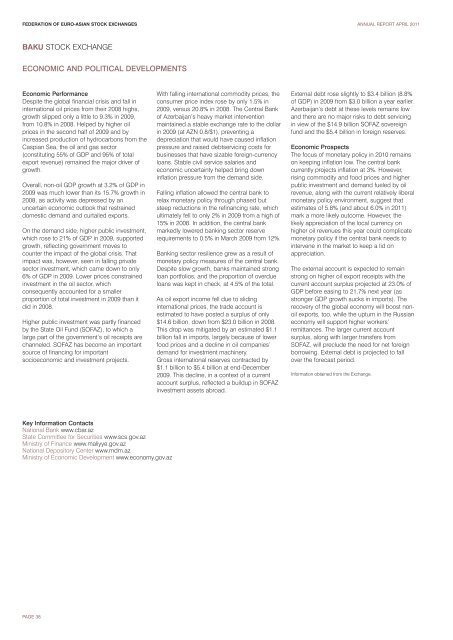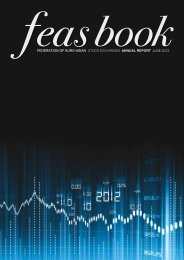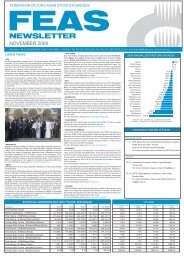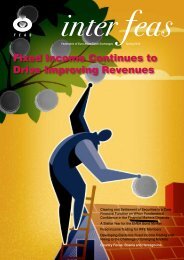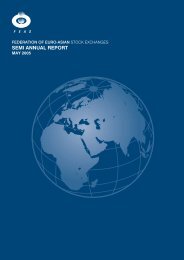Download - FEAS
Download - FEAS
Download - FEAS
Create successful ePaper yourself
Turn your PDF publications into a flip-book with our unique Google optimized e-Paper software.
FEDERATION OF EURO-ASIAN STOCK EXCHANGES ANNUAL REPORT APRIL 2011<br />
BAKU STOCK EXCHANGE<br />
ECONOMIC AND POLITICAL DEVELOPMENTS<br />
Economic Performance<br />
Despite the global financial crisis and fall in<br />
international oil prices from their 2008 highs,<br />
growth slipped only a little to 9.3% in 2009,<br />
from 10.8% in 2008. Helped by higher oil<br />
prices in the second half of 2009 and by<br />
increased production of hydrocarbons from the<br />
Caspian Sea, the oil and gas sector<br />
(constituting 55% of GDP and 95% of total<br />
export revenue) remained the major driver of<br />
growth.<br />
Overall, non-oil GDP growth at 3.2% of GDP in<br />
2009 was much lower than its 15.7% growth in<br />
2008, as activity was depressed by an<br />
uncertain economic outlook that restrained<br />
domestic demand and curtailed exports.<br />
On the demand side, higher public investment,<br />
which rose to 21% of GDP in 2009, supported<br />
growth, reflecting government moves to<br />
counter the impact of the global crisis. That<br />
impact was, however, seen in falling private<br />
sector investment, which came down to only<br />
6% of GDP in 2009. Lower prices constrained<br />
investment in the oil sector, which<br />
consequently accounted for a smaller<br />
proportion of total investment in 2009 than it<br />
did in 2008.<br />
Higher public investment was partly financed<br />
by the State Oil Fund (SOFAZ), to which a<br />
large part of the government’s oil receipts are<br />
channeled. SOFAZ has become an important<br />
source of financing for important<br />
socioeconomic and investment projects.<br />
With falling international commodity prices, the<br />
consumer price index rose by only 1.5% in<br />
2009, versus 20.8% in 2008. The Central Bank<br />
of Azerbaijan’s heavy market intervention<br />
maintained a stable exchange rate to the dollar<br />
in 2009 (at AZN 0.8/$1), preventing a<br />
depreciation that would have caused inflation<br />
pressure and raised debtservicing costs for<br />
businesses that have sizable foreign-currency<br />
loans. Stable civil service salaries and<br />
economic uncertainty helped bring down<br />
inflation pressure from the demand side.<br />
Falling inflation allowed the central bank to<br />
relax monetary policy through phased but<br />
steep reductions in the refinancing rate, which<br />
ultimately fell to only 2% in 2009 from a high of<br />
15% in 2008. In addition, the central bank<br />
markedly lowered banking sector reserve<br />
requirements to 0.5% in March 2009 from 12%.<br />
Banking sector resilience grew as a result of<br />
monetary policy measures of the central bank.<br />
Despite slow growth, banks maintained strong<br />
loan portfolios, and the proportion of overdue<br />
loans was kept in check, at 4.5% of the total.<br />
As oil export income fell due to sliding<br />
international prices, the trade account is<br />
estimated to have posted a surplus of only<br />
$14.6 billion, down from $23.0 billion in 2008.<br />
This drop was mitigated by an estimated $1.1<br />
billion fall in imports, largely because of lower<br />
food prices and a decline in oil companies’<br />
demand for investment machinery.<br />
Gross international reserves contracted by<br />
$1.1 billion to $5.4 billion at end-December<br />
2009. This decline, in a context of a current<br />
account surplus, reflected a buildup in SOFAZ<br />
investment assets abroad.<br />
External debt rose slightly to $3.4 billion (8.8%<br />
of GDP) in 2009 from $3.0 billion a year earlier.<br />
Azerbaijan’s debt at these levels remains low<br />
and there are no major risks to debt servicing<br />
in view of the $14.9 billion SOFAZ sovereign<br />
fund and the $5.4 billion in foreign reserves.<br />
Economic Prospects<br />
The focus of monetary policy in 2010 remains<br />
on keeping inflation low. The central bank<br />
currently projects inflation at 3%. However,<br />
rising commodity and food prices and higher<br />
public investment and demand fueled by oil<br />
revenue, along with the current relatively liberal<br />
monetary policy environment, suggest that<br />
estimates of 5.8% (and about 6.0% in 2011)<br />
mark a more likely outcome. However, the<br />
likely appreciation of the local currency on<br />
higher oil revenues this year could complicate<br />
monetary policy if the central bank needs to<br />
intervene in the market to keep a lid on<br />
appreciation.<br />
The external account is expected to remain<br />
strong on higher oil export receipts with the<br />
current account surplus projected at 23.0% of<br />
GDP before easing to 21.7% next year (as<br />
stronger GDP growth sucks in imports). The<br />
recovery of the global economy will boost nonoil<br />
exports, too, while the upturn in the Russian<br />
economy will support higher workers’<br />
remittances. The larger current account<br />
surplus, along with larger transfers from<br />
SOFAZ, will preclude the need for net foreign<br />
borrowing. External debt is projected to fall<br />
over the forecast period.<br />
Information obtained from the Exchange.<br />
Key Information Contacts<br />
National Bank www.cbar.az<br />
State Committee for Securities www.scs.gov.az<br />
Ministry of Finance www.maliyye.gov.az<br />
National Depository Center www.mdm.az<br />
Ministry of Economic Development www.economy.gov.az<br />
PAGE 38


